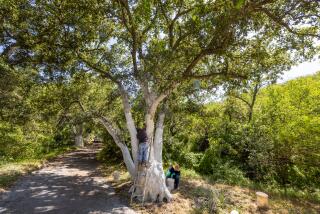Voracious Beetle Kills Ash-Tree Sales
- Share via
TOLEDO, Ohio — A Chinese beetle that crept into Ohio after killing millions of ash trees in Michigan is eating away at the tree industry in states much farther away.
West Coast nursery owners who supply the Midwest with seedlings say there are fewer customers willing to take a chance on ash trees, once a popular choice for their hardiness.
“There’s a surplus of ash trees right now because people aren’t sure what’s going to happen,” said Devin Cooper, owner of Willamette Nurseries in Canby, Ore. “We’ve had people cut back orders and cancel orders.”
He has 70,000 seedlings worth about $40,000 that he can’t get rid of. “I don’t know if I’ll have to burn them or replant them,” Cooper said.
Scientists believe that the emerald ash borer arrived in the United States from its native China with wood used to pack cargo.
The beetle has infested or destroyed about 6 million ash trees in southeast Michigan, mostly near Detroit, and has been found in northwest Ohio and Maryland.
At North Branch Nursery in Pemberville near Toledo, a field of about 2,700 ash trees will probably be turned into mulch, owner Tom Oberhouse said. The loss could be as much as $300,000.
“Our trees are healthy, but there’s no market for them,” said Oberhouse, who, in a good year, sells about 1,200 ash trees to landscapers and garden centers. In 2003, he sold 200.
He won’t be buying any more ash seedlings from Oregon, where he normally would get as many as 25,000 a year.
Nursery owners who supply trees in the Midwest are already trying to figure out what trees will replace the ash.
“It’s kind of ironic because we’re growing and selling more hybrid elms that are resistant to Dutch elm disease,” Oberhouse said.
That disease carried by bark beetles ravaged more than half the nation’s elm population after being discovered in Ohio in the 1930s.
Many towns that lost elm trees replaced them with ash trees, thought to be disease-resistant.
Some tree growers have turned to maples and poplars instead of ash.
“There’s no sense in planting them if they’re not going to sell,” said Clayton Wilcher, who runs Wilcher’s Nursery in Rock Island, Tenn. “I’m waiting to see what happens. If it settles down, maybe in three or four years, it will blow over.”
For that to happen, researchers must find a way to stop the beetle from spreading. So far, there’s no insecticide that can do it, and the beetle doesn’t have any known natural predators.
“Right now, the only control is chopping down the trees,” said Bill Stalter, executive director of the Ohio Nursery & Landscape Assn. Its survey of 100 tree growers in Ohio found that the combined value of their ash trees was $20.2 million.
Michigan has banned the sale of ash trees in the lower peninsula through August in hopes of gaining control of the pest. In southeastern Michigan, where the ash borer was detected last year, growers have lost at least $9 million in sales. That doesn’t include losses by retail garden centers and landscapers.
“It’s just devastating to our industry here,” said Amy Frankmann, executive director of the Michigan Nursery & Landscape Assn. “It was the tree of choice. It grew anywhere through drought or rain.”
She said one tree grower has lost $1 million in sales, and it will cost $500,000 to remove his trees from the fields.
Ash trees can take from three to five years to mature from seedlings, so many growers are facing a difficult choice on whether to plant them without knowing what’s ahead.
“I think the cautious grower is going to sit back and see what happens,” Stalter said. “Wholesale growers are going to hold off.”
More to Read
Sign up for Essential California
The most important California stories and recommendations in your inbox every morning.
You may occasionally receive promotional content from the Los Angeles Times.













